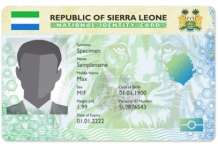By Amin Kef Sesay
Deforestation, defined by the United States Environmental Protection Agency as the “permanent removal of standing forests” has become an existential threat to all rural communities.
With the country’s forest cover fast disappearing; the Ministries of Lands, Forestry, Environment, Agriculture and Water Resources should show great concern for environmental conservation by the recent happening in Tonko Limba Chiefdom in Kambia district.
The people report that their water wells and clean water sources for the first time in living history have all dried up. This, they attribute, to the increased deforestation in the chiefdom and the district from mainly logging and farming activities.
While it is known that forests can be a buffer against the impacts of climate change, deforestation it can also reduce communities’ access to clean drinking water, as seen now in Tonko Limba where even deep borehole wells have run dry.
As such, the imperative for Government to put in place a robust and sustained well-funded national reforestation program in areas where deforestation has been devastating cannot be overemphasized; given the correlation between deforestation, water scarcity, environmental degradation and the worst effects of climate change.
Healthy forests are critical to providing clean water. Erosion—when rainfall, runoff or wind detaches soil particles—is a significant problem that affects both water quality and quantity.
Healthy forests act as a filter to keep pollution out of water. Strong roots anchor soil against erosion and material on the forest floor helps absorb nutrients and sediment. When forests are disturbed and degraded, sediment flows into streams and pollute water.
Forests help control the water cycle by regulating precipitation, evaporation and flows. Layers of forest canopy, branches and roots can store and release water vapor, which controls rainfall. Forests can also help reduce the impacts of flood from storms by blocking and slowing down the flow of runoff. Deforestation weakens this process, leading to irregular rainfall patterns including drought and flooding.
The loss of trees and other vegetation can cause climate change, desertification, soil erosion, fewer crops, flooding, increased greenhouse gases in the atmosphere, and a host of problems for indigenous people.
Loss of Habitat
One of the most dangerous and unsettling effects of deforestation is the loss of animal and plant species due to their loss of habitat, as many land animals and plant species live in forests. Not only does deforestation threaten species known to us but also those unknown. The trees of the rainforest that provide shelter for some species also provide the canopy that regulates the temperature. Deforestation results in a more drastic temperature variation from day to night.
Increased Greenhouse Gases
In addition to the loss of habitat, the lack of trees also allows a greater amount of greenhouse gases into the atmosphere. Healthy forests absorb carbon dioxide from the atmosphere, acting as valuable carbon sinks. Deforested areas lose that ability and release more carbon.
Water in the Atmosphere
The trees also help control the level of water in the atmosphere by helping to regulate the water cycle. In deforested areas, there is less water in the air to return to the soil. This then causes dryer soil and the inability to grow crops.
Soil Erosion and Flooding
Further effects of deforestation include soil erosion and coastal flooding. Trees help the land to retain water and topsoil, which provides the rich nutrients to sustain additional forest life. Without forests, the soil erodes and washes away, causing farmers to move on and perpetuate the cycle. The barren land left behind in the wake of this unsustainable agricultural practice is then more susceptible to flooding.




